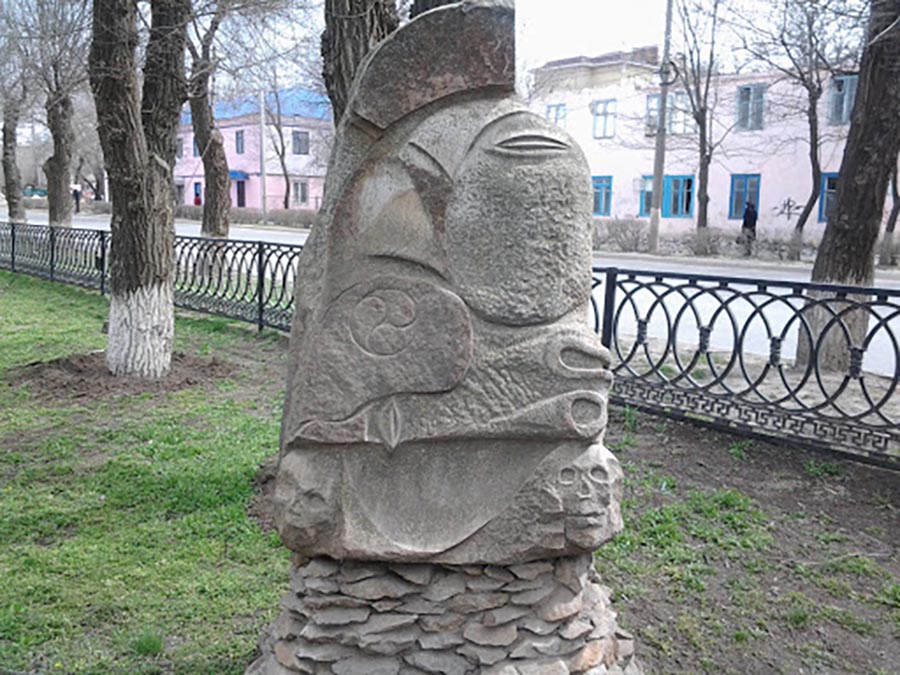
Скульптура «Джунгарские ворота»
Композиция вытянутой по вертикали и округлой по форме стелы.
По замыслу автора это символ слитых воедино человека и коня. В Семипалатинской области Казахстана есть ущелье, через которое веками ойраты Джунгарии проходили на Запад и которое носит название – Джунгарские ворота. В этом ущелье постоянный шквальный ветер, ворочающий огромные булыжники. Поэтому в скульптуре из песчаника изображены слитые воедино головы всадника и коня, летящие вместе к цели, вопреки встающим на их пути преградам. На одной стороне нагромождение множества символов.
В нижней части по краям имеется изображение лица человека и человеческого черепа, между ними – вогнутая, отшлифованная плоскость, выше – на светлой стороне – рельефные круги и бороздки, приплюснутые диски, слева - на темном фоне каплевидной формы круг с тройственным знаком, объясняемым как символ тройственности Бытия, символ Трех Драгоценностей в буддизме. Вверху удлиненный круг с тремя длинными горизонтальными полосками в виде глаза. Левее круга пять треугольников светлого, темного цветов. Всю композицию на этой стороне венчает навершие, в которой угадывается фигура птицы. Скульптуру опоясывает орнамент в виде плетеной косы, которая, извиваясь по кругу, сужается кверху, приобретая форму змеи с высунутым жалом. С обратной стороны - необработанная фактура камня, усеченная сбоку и окрашенная в темный цвет.
Автор попытался изобразить исторические отношения двух кочевых народов: калмыков и казахов. В скульптуре слиты воедино голова всадника и коня, летящих к цели, вопреки всем преградам.
Материал: песчаник.
Автор: Е.Рахмадиев (в рамках Международного симпозиума скульпторов), 1997г.
Sculpture "Dzungarian Gate"
A composition of a vertically elongated and rounded stele.
As conceived by the author, this is a symbol of a man and a horse fused together. In the Semipalatinsk region of Kazakhstan, there is a gorge through which for centuries the Dzungaria Oirats passed to the West and which is called the Dzungarian Gate. In this gorge, there is a constant gusty wind, rolling over huge cobblestones. Therefore, the sandstone sculpture depicts the heads of a rider and a horse fused together, flying together towards the goal, despite the obstacles that stand in their way. On one side, a pile of many symbols.
In the lower part, along the edges, there is an image of a person's face and a human skull, between them is a concave, polished plane, above - on the light side - relief circles and grooves, flattened discs, on the left - on a dark background, a teardrop-shaped circle with a triple sign, explained as a symbol the triplicity of Being, a symbol of the Three Jewels in Buddhism. At the top is an elongated circle with three long horizontal stripes in the form of an eye. To the left of the circle there are five triangles of light, dark colors. The whole composition on this side is crowned with a pommel, in which the figure of a bird is guessed. The sculpture is surrounded by an ornament in the form of a braided braid, which, wriggling in a circle, tapers upwards, acquiring the shape of a snake with a protruding sting. On the reverse side there is an untreated stone texture, truncated from the side and painted in a dark color.
The author tried to depict the historical relations of two nomadic peoples: Kalmyks and Kazakhs. The sculpture merges the head of a rider and a horse flying towards the goal, in spite of all obstacles.
Material: sandstone.
Author: E. Rakhmadiev (within the framework of the International Symposium of Sculptors), 1997